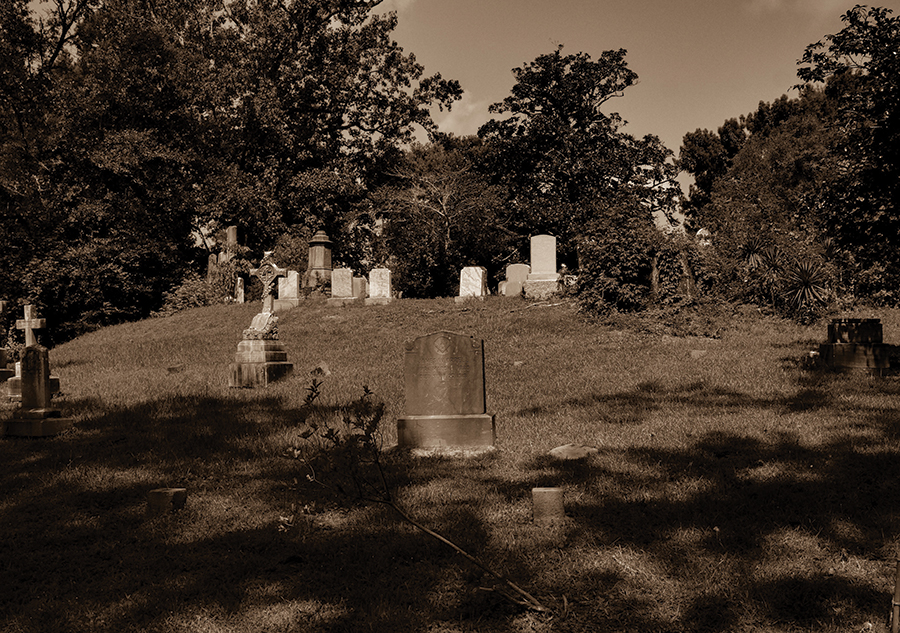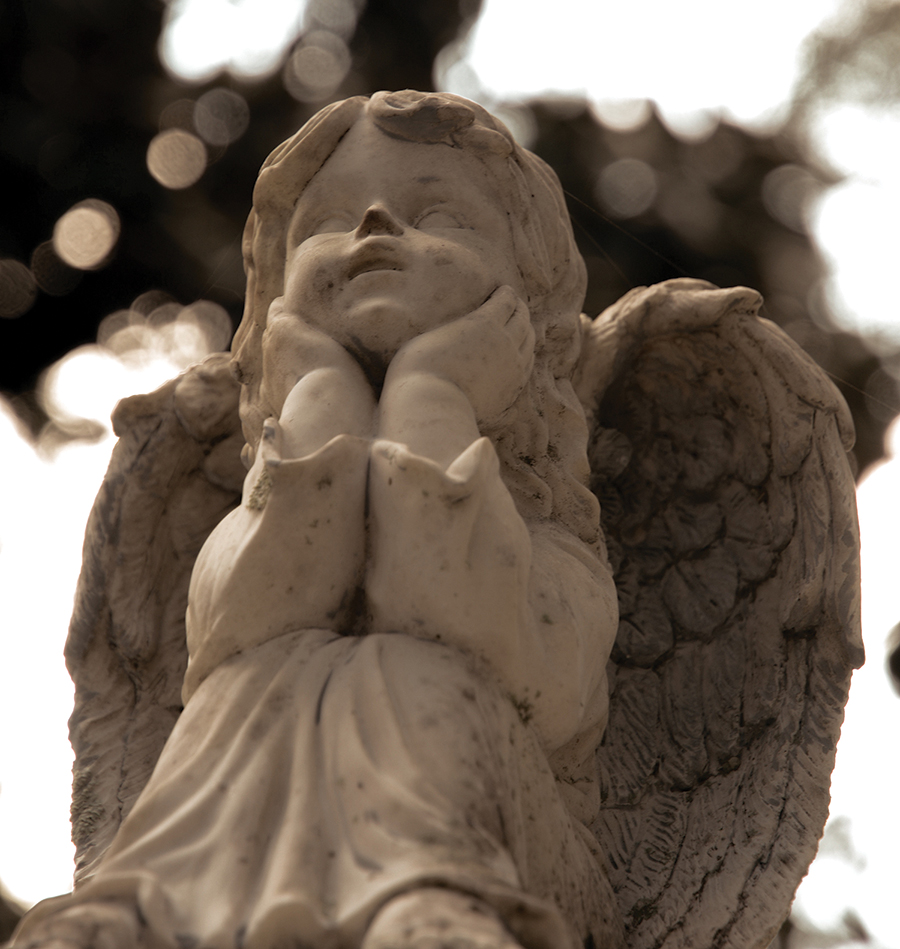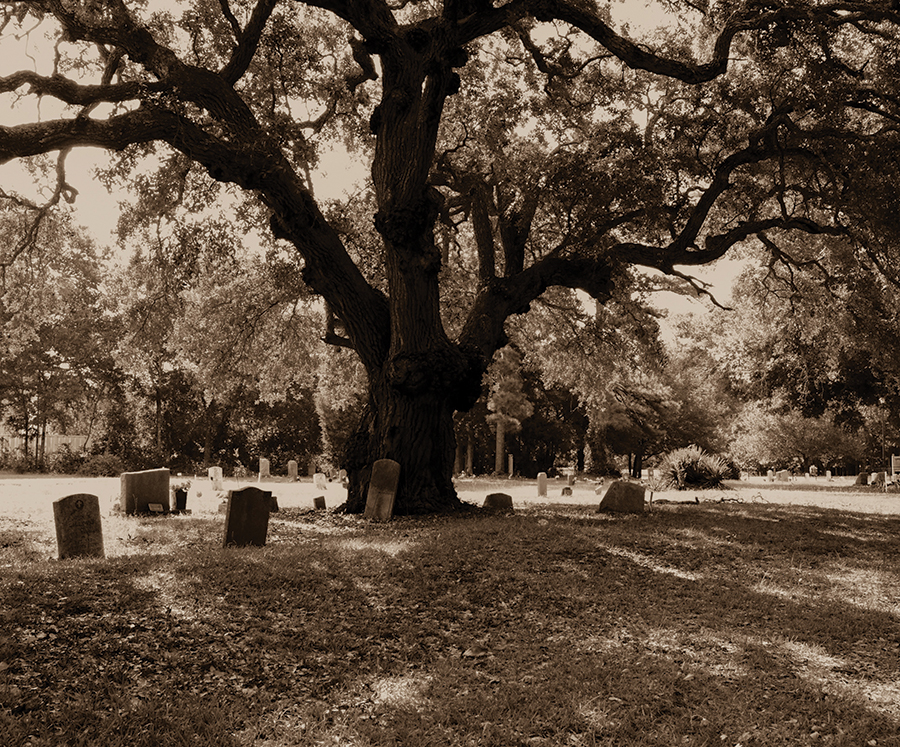The burying grounds and graveyards of the Cape Fear region are places of incomparable beauty and serenity
Story and Photographs by Virginia Holman
In October, it’s fun to think of old graveyards as eerie places, frequented by restless spirits and unsettling Edward Goreyesque characters. Yet the graveyards and cemeteries in the Cape Fear region aren’t simply a stop on the old Wilmington ghost tours, they are complex as any community, and archives of our past. Here are three sites among the many in our area well worth visiting.

Oakdale Cemetery (1852)
Although many people visit Oakdale Cemetery for its history and beauty, others are also drawn by its haunting tales. Two of the most visited gravesites are for those who are remembered for their strange departures. The tragic end of Nancy Adams Martin seems torn from the pages of a story by Edgar Allan Poe, and haunts many visitors. In 1857, she perished while on a long shipping voyage with her father (the captain) and her brother. Days from a nearby port, her brother and father decided to preserve her body in one of the large casks of whiskey they had onboard. In order to prevent damage to her remains, they tied her body upright in a chair and affixed it inside an empty cask. They then filled and sealed the cask with the spirits. Rather than return home, Capt. Martin decided to continue his voyage, a decision that multiplied his grief. Four months after Nancy’s death, his son was swept from the deck during a terrific storm, never to be seen again. Upon Capt. Martin’s return to Wilmington, Nancy was buried as she was preserved. A large pit was dug, and the entire cask was buried. A small crooked cross that reads “Nance” marks her gravesite, and a plain white obelisk memorializes the loss of the siblings at sea.
Another point of interest is the grave of William Ellerbrock, a German immigrant, local riverboat captain and volunteer fireman, who was rarely seen without his stalwart dog, Boss. When a raging warehouse fire erupted at Front and Dock streets, workers rushed out, but young Capt. Ellerbrock ran inside the building. Local storytellers say that the crowd heard Ellerbrock cry out for help, but the brutal heat overcame his would-be rescuers before they could enter the building. When Boss heard the cries of his companion, he raced in to help. Both perished in the inferno; their remains were located a mere 10 feet from the doorway. Boss was found beside the captain, a scrap of cloth from Ellerbrock’s coat clutched in his teeth. The two are buried together, and a carving of Boss on the back of Capt. Ellerbrock’s obelisk with the inscription “faithful unto death” memorializes the inseparable duo’s valor.
Across the river in Southport, two cemeteries, Old Smithville Burying Grounds and the John N. Smith Cemetery, are neighbors separated by less than a mile. Each harbors notable members of the community and its own fascinating stories.

The Old Smithville Burying Grounds (1790s)
The final resting place for more than 1,200 souls sits on two acres of high ground not far from the river. The cemetery was founded in the 1790s, a time when Southport was known as Smithville. It’s a peaceful place to visit, shaded beneath live oaks and ancient magnolias. Some of the headstones appear blank, their inscriptions erased by time. Other monuments have shifted and lean at strange angles to accommodate the massive tree roots that vein the ground. One of the more intriguing residents of the Old Burying Grounds is Capt. L. C. “Crattie” Arnold. He was born in 1883. As a young child, he contracted spinal meningitis, and the disease rendered his legs withered and useless. At age 7, his family had his legs surgically removed. They were then buried in the family plot with a stone that read “His Legs.” Crattie went on to lead a productive life as a husband, father and master boat builder. He passed away in 1967. A headstone in the cemetery bears his name; sadly, the marker for his legs can no longer be found.

The John N. Smith Cemetery (1880)
Just around the corner on East Leonard Street, the John N. Smith Cemetery (named after in the first man buried there, in 1874) is one of our state’s treasures. This cemetery was founded in 1880 by a local African-American church. Smithville Cemetery, like many private Southern cemeteries at the time, refused to bury black community members. (In fact, North Carolina did not prohibit cemeteries from discriminating on the basis of race until 1975.) This peaceful, well-tended historic site is shaded by burled live oaks with sprawling canopies — some of the most magnificent trees in our region, and several headstones are decorated with small mounds of seashells and knobbed whelks, an African tradition maintained by the Gullahs. The shells honor the belief that “the sea made us; and the sea shall take us back.” This graveyard is the final resting place of the many notable African-American citizens of Southport. Its graves include two Civil War veterans as well as local business owners and educators.
The cemetery fell into a state of disrepair in the 1950s, but in recent years a group of local citizens, led by Judy Gordon, has come together to protect and restore this splendid site. (Gordon’s grandfather, Frank Gordon, was the first African-American educator in Brunswick County and is buried here.) The cemetery still has numerous unmarked graves, and efforts are underway to use ground-penetrating radar to help find and mark those graves lost to time. A nonprofit group was formed to help maintain this important historic site, and a grant from the Orton Foundation helped the group install a fence around the 3 1/2-acre site.
Due to these efforts, the welcome sign at the John N. Smith Cemetery is now rendered in the same elegant blue-painted script as the Smithville Cemetery. It highlights the resting place of one of Southport’s most famous citizens, Elias Gore, a 7-foot, 11-inch-tall local menhaden fisherman affectionately nicknamed “Nehi.” He was known to be a gentle giant who worked so hard that he earned the wages of two men. For a brief time, he modeled clothing for a company in New York, but soon returned to his hometown where he could be a family man and not just a curiosity. He’s remembered fondly to this day as a man who loved children, and who helped send his brothers and sisters to school.
For more information: Oakdale Cemetery: oakdalecemetery.org
Old Smithville Burying Grounds: southporthistoricalsociety.org
John N. Smith Cemetery: johnnsmithcemetery.org
Virginia Holman is a regular Salt contributor and teaches in the creative writing department at UNCW.


